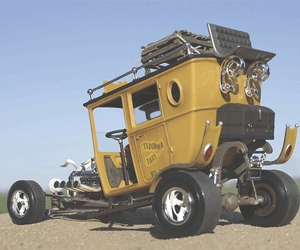RoR Project PC1970 – Trash to Treasure
RoR Project PC1970 – Trash to Treasure          Â

Figure 0 -Â 1970 Oldsmobile Indy 500 Pace Car
            As mentioned in the main post the body of this toy is well detailed and with the addition of some Fred CadyTM decals this “junk†was transformed into a nice display piece.

Figure 1 – ToymaxTM 1970 Olds 442 W-30
           For the modeler there are number of interesting techniques used in this conversion. Third party decal use, window repairs, blackout painting, side marker highlighting and body preparation were all featured in this project.
           The first step to the conversion is to turn the model upside down and remove the dry cells. The reason for this is that if they are left in the unit over a long period of time they might corrode and leak causing some damage.
           Use a #1 Phillips screwdriver to remove the fastening screws from the chassis side and the electronics by using a side cutter to snip the wire leads. You could leave them in place but it’s more difficult to work with the bumpers and the chassis needs to be separated from the body at least for easier construction.
           Remove the front and rear bumpers.
            Use a brush to “paint†the body stickers with some acetone or lighter fluid to dissolve the adhesive and remove them from the body. After the stickers are removed, wipe the remaining adhesive from the plastic body with a soft cloth and the same solvent.
           You’ll end up with a clean looking body that can be prepared for painting and repair.
           This model has a hole in the windshield for some of the lighting effects of the toy but that is unacceptable for a Pace Car model.
           Fill the hole with some putty or filler and prep it for painting by taping off the windshield and lightly sanding the rest of the windshield then spray paint the window with some gloss black paint.
           Reverse the masking after the window has dried and spray the body with a light primer followed-up with bright white tack and color coats for a rich finish. As an option you can use a wash to make those panel lines “pop†and give the model a distinctive appearance. This is done by mixing equal parts of black acrylic paint, water and dish soap together and painting the panel lines. After it has dried, use a slightly damp cloth to wipe the excess paint off the body by rubbing it transverse to the panel lines. The following photo (Figure 9) shows the results these painting techniques.
           Now you can start adding your decals to the model. Fred Cady used to make a variety of third party decals. Many of them were available for the pace cars and are still available from suppliers online.
           Add some side marker tint by placing a thinned drop of the appropriate color into each of the well formed side marker details then highlight the trim with a silver marker or dry-brushing for a realistic appearance.
           Add some of the same orange marker tint to the turn signal indicators on the front bumper and then thin out some flat black to “blackout†the grill by placing your brush over each feature and letting some paint flow to the base.
           Remove the ToymaxTM rear license plate sticker and replace it with the Fred CadyTM Indiana plate.
           Use a small drill to bore a couple of equally spaced holes in the rear bumper to mount the pace car flag poles. Make a couple flag poles from plastic rod stock like the EvergreenTM products or use a couple clean round toothpicks for the poles. Cut out a couple yellow/orange flags from paper stock or thin cloth and adhere the edge to the poles.
           Place the bumpers onto their respective posts and reassemble the chassis to the body using the original fasteners.
           Give the model an overall coating of clear paint and then place the pace car flags into their receptacles on the rear bumper and there you go – treasure, right out of the trash can!
           As with any model there were some tradeoffs with this project. Further detailing of the undercarriage and wheels are the major improvements that could be made. You can determine how to complete your project to your satisfaction but always remember to keep your eyes open – you never where you’ll find that next gem in the rough!
















